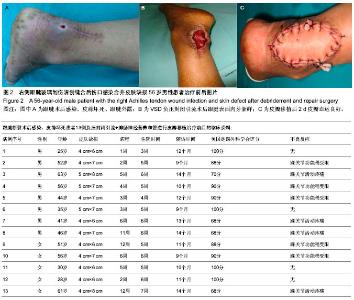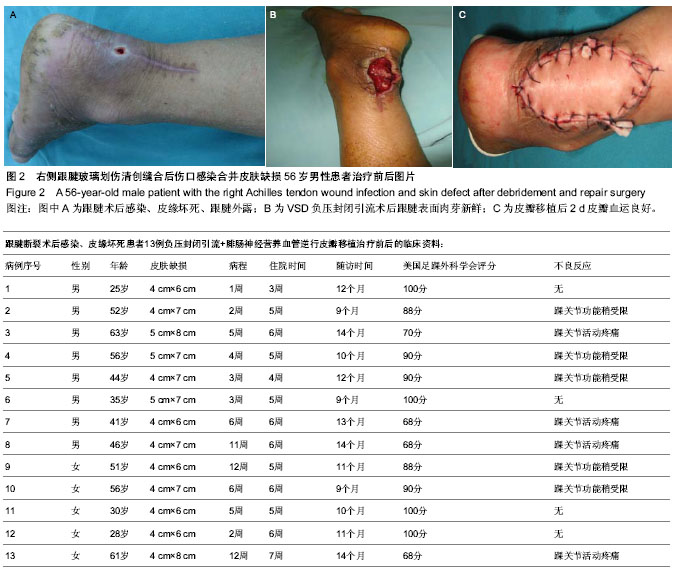| [1] 张喜海,卓乃强,鲁晓波.游离组织瓣联合游离植皮负压封闭引流技术修复肢体严重创伤后大面积软组织缺损46例[J].重庆医学, 2014,33(1):114-115,116.
[2] 邓凯,喻爱喜,余国荣,等.传统纱布开放换药与负压封闭引流技术临时治疗不同软组织缺损的疗效比较[J].中华创伤骨科杂志, 2012,14(10):854-858.
[3] 陈长青,郭林新,林山,等.封闭负压引流在四肢创伤性软组织缺损中的应用[J].临床骨科杂志,200912(4):440-442.
[4] 侯彦杰,丁慧勇.应用VSD技术和皮神经营养血管皮瓣逆行转移治疗手和足踝部的组织缺损63例分析[J].中国误诊学杂志,2011, 11(22):5440-5441.
[5] 陈海磊.封闭负压引流技术在下肢撕脱伤合并骨外露中的应用体会[J]. 交通医学, 2010,24(1):45-46.
[6] 石波,王军,杨衡,等.负压封闭引流在肢体毁损伤保肢术的急诊应用[J].生物骨科材料与临床研究,2011,8(4):47-49.
[7] Mullner T,Mrkonjic L,Kwasny O,et al,The use of negative pressure to promoye the healing of tissue defects;a clinical trial using the vacuum sealing technique.Br J Plast Surg. 1999;42:589-594.
[8] 潘璐璐,方一呜,林崇翔,等.负压封闭引流联合局部药物冲洗治疗颌面颈部间隙感染的临床观察[J].口腔颌面外科杂志,2012, 22(6): 405-408.
[9] 龙冰,李启芬,张毅,等.持续负压封闭引流在创伤外科中的应用[J].中华现代外科学杂志,2005,2(8):59.
[10] Lavery LA,La Fontaine J,Thakral G,et al.Randomized clinical trial to compare negative-pressure wound therapy approaches with low and high pressure, silicone-coated dressing, and polyurethane foam dressing.Plast Reconstr Surg. 2014;133(3):722-726.
[11] Zhang WK,Zhang WK,Wang HB,et al.Vacuum sealing drainage and free coupling chain-link posterior tibial artery flap in the reconstruction of degloving injury of propodium.Zhonghua Zheng Xing Wai Ke Za Zhi.2013;29(4):258-260.
[12] Qu J,Yan R,Wang L,et al.Free dermatoplasty combined with vacuum sealing drainage for the treatment of large-area soft tissue defects accompanied by bone exposure in the lower leg.Exp Ther Med.2013;5(5):1375-1380.
[13] Zhang L,Quan C,Jiang J,et al.The combined application of dissociate skin flap and vacuum sealing drainage on the defect of the large neck neoplasms after surgical procedures.Lin Chung Er Bi Yan Hou Tou Jing Wai Ke Za Zhi.2012;26(24):1113-1115.
[14] Ren GH,Li JW,Li RG,et al.Treatment of large circular soft tissue defect in lower extremities with a combination of bridge flaps and free skin graft covered by vacuum sealing drainage.Zhonghua Wai Ke Za Zhi. 2012;50(1):39-44.
[15] Chen Q,Liu DS,Hu W,et al.Treatment of high-pressure paint injection injuries of hand with debridement combined with vacuum sealing drainage technique.Zhongguo Gu Shang. 2011;24(10):851-853.
[16] Li RG, Yu B, Wang G,et al. Sequential therapy of vacuum sealing drainage and free-flap transplantation for children with extensive soft-tissue defects below the knee in the extremities. Injury.2012;43(6):822-828.doi: 10.1016/j.injury.2011.09.031
[17] 蔡晓斌,刘云健,吴凌峰,等.远端蒂皮瓣修复肢体远端皮肤软组织缺损[J].实用骨科杂志,2008,14(7):398-400.
[18] 马辉,孙建强.应用低旋转点逆行外踝上皮瓣修复跟骨骨折术后皮肤软组织坏死缺损疗效分析[J].中国实用医药,2011,6(9):93-94.
[19] John JR,Tripathy S,Sharma RK,et al.Peroneal artery perforator-based flaps for reconstruction of middle and lower third post-traumatic defects of the leg.ANZ J Surg. 2014.doi: 10.1111/ans.12556.[Epub ahead of print]
[20] Fan C,Ruan H,Cai P,et al.Repair of soft tissue defects of lower extremity by using cross-bridge contralateral distally based posterior tibial artery perforator flaps or peroneal artery perforator flaps.Zhongguo Xiu Fu Chong Jian Wai Ke Za Zhi. 2011; 25(7):826-829.
[21] Gir P,Cheng A,Oni G,et al.Pedicled-perforator (propeller) flaps in lower extremity defects: a systematic review.J Reconstr Microsurg.2012;28(9):595-601.
[22] Mateev MA, Kuokkanen HO. Reconstruction of soft tissue defects in the extremities with a pedicled perforator flap: series of 25 patients.J Plast Surg Hand Surg. 2012; 46(1):32-36.
[23] Rad AN,Singh NK,Rosson GD.Peroneal artery perforator-based propeller flap reconstruction of the lateral distal lower extremity after tumor extirpation: case report and literature review.Microsurgery.2008;28(8):663-670.
[24] Prasad V, Morris SF. Propeller DICAP flap for a large defect on the back-case report and review of the literature. Microsurgery. 2012;32(8):617-621.
[25] Brunetti B,Tenna S,Aveta A,et al. Free-style local perforator flaps: versatility of the v-y design to reconstruct soft-tissue defects in the skin cancer population.Plast Reconstr Surg. 2013; 132(2):451-460.
[26] Arco G,Horch RE,Arkudas A,et al.Double pedicled perforator flap to close flank defects: an alternative for closure of a large lumbar defect after basalioma excision--a case report and review of the literature.Ann Plast Surg.2009; 63(4):422-424.
[27] Dessy LA,Figus A,Fioramonti P, et al. Reconstruction of anterior auricular conchal defect after malignancy excision: revolving-door flap versus full-thickness skin graft.J Plast Reconstr Aesthet Surg.2010;63(5):746-752.
[28] Turan A, Turkaslan T, Kul Z,et al.Reconstruction of the anterior surface of the ear using a postauricular pull-through neurovascular island flap.Ann Plast Surg. 2006; 56(6): 609-613.
[29] 刘志雄.骨科常用诊断分类方法和功能结果评定标准[M].北京:科学技术出版社,2005:280-281.
[30] Shoufani A,Samuelov R.Vacuum assisted closure--a new method for wound control and treatment. Harefuah. 2003; 142(12):837-40,877.
[31] Labler L,Trentz O.The use of vacuum assisted closure (VAC) in soft tissue injuries after high energy pelvic trauma. Langenbecks Arch Surg.2007;392(5):601-609.
[32] 刘华水,楚万忠,栾涛,等.闭式负压引流联合带腓肠神经营养血管皮瓣修复近踝足部肌腱与骨外露创面[J].中国骨伤,2010, 23(8):613-615.
[33] 裘曙文,黄武君,何勇,等.封闭式负压引流技术联合腓肠神经营养血管皮瓣治疗跟腱部软组织缺损[J].中国修复重建外科杂志, 2011,25(5):637-638.
[34] Loonen MP,Kon M,Schuurman AH,et al.Venous bypass drainage of the small saphenous vein in the neurovascular pedicle of the sural flap: anatomical study and clinical implications.Plast Reconstr Surg.2007;120(7):1898-1905.
[35] Noack N,Hartmann B,Küntscher MV.Measures to prevent complications of distally based neurovascular sural flaps.Ann Plast Surg.2006;57(1):37-40.
[36] Sladjana UZ,Ivan JD,Ljiljana VP,et al.Neurovascular stalk of the superficial sural flap: human fetus anatomical study. Plast Reconstr Surg.2005;116(2):546-550.
[37] 韦健,洪定钢,王效柱.负压封闭引流联合带腓肠神经营养血管的筋膜皮瓣在修复跟腱断裂术后感染的应用[J].贵阳中医学院学报, 2012,34(3):45-46. |



